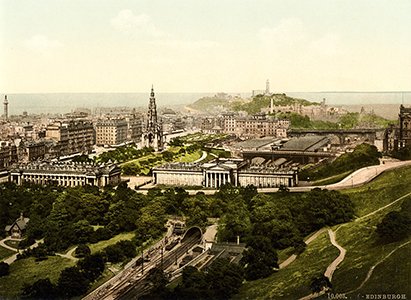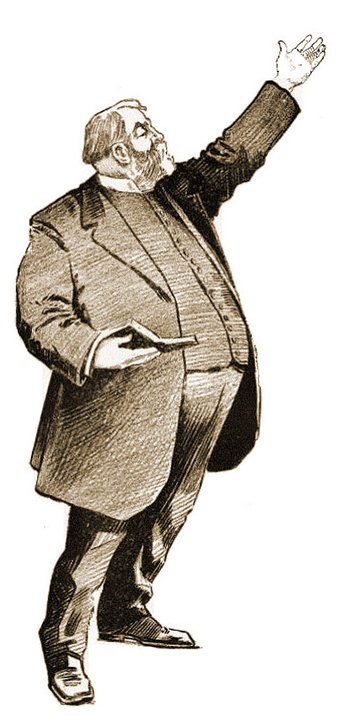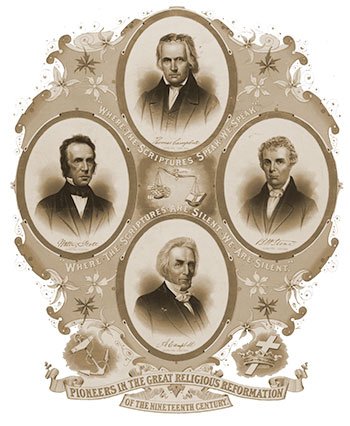1859 James Turner Revivals in Scotland

Edinburgh 1890’s
The James Turner revivals were a series of impactful spiritual awakenings that occurred in Scotland during the mid-19th century. These revivals, led by the fervent evangelist James Turner, left a lasting mark on the religious landscape of Scotland and contributed significantly to the growth of evangelical Christianity. This article delves into the historical context, key figures, and lasting impact of the James Turner revivals, drawing upon a variety of sources to provide a comprehensive overview.
The State of Scotland Before the Revivals
In the mid-19th century, Scotland found itself in a complex social and political environment. The country was undergoing significant changes, with the Industrial Revolution transforming its economy and society. While politically stable, with the Acts of Union of 1707 firmly establishing the Kingdom of Great Britain, there was a growing sense of social unrest and concern about moral decline1.
Amidst these societal shifts, the spiritual state of Scotland was also a cause for concern. While the country had a rich Christian heritage, formal religion had become commonplace, and many had grown complacent in their faith3. The General Assembly of the Church of Scotland in 1859 acknowledged “gratifying evidences manifested in many countries, and in various districts of our own land, of an increased anxiety about salvation,” but also expressed caution about potential abuses and discouragement of genuine faith4.
The fishing villages along the Moray coast were particularly known for their lack of interest in education and the prevalence of “ungodliness and moral degradation.” 3 The people were described as “rough,” “reckless,” and “greatly addicted to whisky-drinking.” 3 This moral climate created a fertile ground for the spiritual awakening that would soon sweep through the region.
The spiritual awakening in Aberdeen in 1858 marked a turning point5. Prayer meetings were held, and scores of people were professing repentance and decision for Christ each night5. This revival set the stage for the James Turner revivals, which would soon ignite a spiritual fire across the fishing villages of northeast Scotland.
James Turner: The Man and His Ministry
James Turner, born in Peterhead, Aberdeenshire in 1818, was a fish-curer by trade4. His early life was marked by poverty and a lack of formal education6. However, at the age of fifteen, he began attending a Bible class, and after a period of spiritual seeking, he experienced a profound conversion in 18406.
From the time he became a Christian, Turner was deeply committed to his faith and actively involved in his local Wesleyan Church. He served as a class leader, diligently praying for the spiritual well-being of each member6. He preached regularly, led prayer meetings, and visited the sick and dying6.
A significant turning point in Turner’s spiritual journey came in 1854 when he experienced what was known as the “Baptism of Fire” or “Christian perfection.” 6 This experience, characterized by a profound outpouring of the Holy Spirit, deepened his faith and empowered him for ministry. He described it as being “cleansed from all sin” and testified to its transformative effect on his life6.
Turner’s ministry was characterized by a deep passion for souls and an unwavering reliance on God6. He was known for his “stern reprover of sin” and his ability to speak of Christ’s love in a way that moved his audience to tears6. He was a man of prayer, constantly seeking God’s guidance and experiencing remarkable answers to his prayers7. He had a reputation for boldness and directness in his preaching, confronting sin and calling people to repentance6.
The Revivals Begin
In 1859, a poor fishing season left Turner with an abundance of unused barrels and time on his hands6. The winter months were typically spent making barrels for the upcoming fishing season, but with the surplus from the previous year, there was little work to be done6. Turner saw this as an opportunity to dedicate himself fully to evangelistic work, a calling he had felt for some time6.
In December 1859, he set out on a mission to the fishing villages along the Moray coast, where he would spend the next five months igniting revival fires6. He felt a particular burden for the fishermen in these villages, and he believed that God had prepared both him and the people for this time of awakening6.
Turner’s ministry was met with remarkable success. In Portknockie, the revival lasted for six weeks, with many experiencing profound conversions3. In Banff, the impact was so significant that it was described as a “wonder in the history of revival.” 3
Results and Manifestations
The James Turner revivals were characterized by a number of notable results and manifestations:
The impact of the revivals was widespread, with conversions happening in various fishing villages along the Moray coast. In Portknockie, the revival began with a group of young men seeking guidance from Turner, and as he prayed with them, the Holy Spirit descended upon them with power3. This marked the beginning of a six-week revival that saw many turn to Christ3.
In Banff, the revival was equally remarkable. People from surrounding towns walked long distances to attend the meetings, and the impact was felt throughout the community3. The town became known for its “crowded meetings,” “the power that attends female prayer meetings,” and the transformed lives of its residents3.
The revivals in Findochty and Portessie were also significant. In Findochty, the revival was described as being “overshadowed with the Holy Ghost,” with illiterate fishermen demonstrating remarkable power in prayer3. In Portessie, the revival led to a significant increase in church attendance and a renewed sense of community among believers5.
- Conversions: Thousands of people were converted during the revivals, with estimates suggesting that as many as 10% of the Scottish population may have been impacted5.
- Church Growth: Churches saw a significant increase in attendance and membership. In some cases, Sunday schools quadrupled in size5.
- Manifestations of the Spirit: The revivals were accompanied by various manifestations of the Spirit. These included:
- Intense prayer meetings: Prayer was a central element of the revivals, with people gathering for extended periods of time to seek God’s blessing3. These meetings were often characterized by a deep sense of God’s presence and a fervent desire for spiritual awakening.
- Public confessions of sin: Many people publicly confessed their sins, expressing deep remorse and a desire for forgiveness3. This created an atmosphere of humility and brokenness before God, contributing to the transformative power of the revivals.
- Physical responses: In some instances, people experienced physical manifestations of the Spirit, such as trembling and falling to the ground5. These physical responses, while not the primary focus of the revivals, were seen as outward expressions of the inner workings of the Holy Spirit.
- Moral Transformation: The revivals led to noticeable moral changes in individuals and communities. People gave up drinking, reconciled broken relationships, and showed greater generosity towards others3.
Other Notable Figures in the Revivals
While James Turner was the central figure in these revivals, other individuals also played significant roles in the spiritual awakening that swept through Scotland. One such figure was Duncan Matheson, an evangelist from Huntly5. Like Turner, Matheson was known for his fervent preaching and his commitment to spreading the Gospel.
Matheson was actively involved in evangelistic work in the years leading up to the revivals, and he played a key role in supporting and extending the work of grace that began in Aberdeen5. He was particularly known for his open-air preaching and his ability to connect with people from all walks of life.
One of Matheson’s most significant contributions was his leadership of the annual Huntly meetings5. These large gatherings, held in the Castle Park in Huntly from 1860 to 1863, brought together believers from across the region for two days of prayer, preaching, and fellowship5. The meetings were a powerful expression of unity and a catalyst for further spiritual growth.
The Legacy of the Revivals
The James Turner revivals had a lasting impact on Scotland and beyond. This legacy can be summarized in the following table:
| Legacy | Description/Evidence |
| Spiritual Renewal | The revivals brought about a renewed emphasis on prayer, repentance, and personal holiness4. They sparked a deeper hunger for God and a greater commitment to living a Christ-centered life. |
| Empowerment of Lay People | The revivals demonstrated the power of lay ministry and encouraged greater involvement of ordinary Christians in evangelism8. They broke down barriers between clergy and laity, empowering individuals to share their faith and contribute to the growth of the church. |
| Growth of Evangelicalism | The revivals contributed significantly to the growth of evangelical Christianity in Scotland and beyond4. They fueled a passion for evangelism and a desire to see the Gospel spread throughout the nation and the world. |
| Social Impact | The revivals had a positive impact on society, leading to decreased crime rates and improved community relations6. They fostered a spirit of unity, reconciliation, and generosity, transforming not only individuals but also the communities in which they lived. |
Timeline of Events
| Year | Event | Location | Key People |
| 1840 | James Turner’s conversion | Peterhead | James Turner |
| 1854 | Turner receives the “Baptism of Fire” | Peterhead | James Turner |
| 1858 | Revival breaks out | Aberdeen | |
| December 1859 | Turner begins revival tour | Moray Coast | James Turner |
| 1860 | Revivals spread to various fishing villages | Banff, Macduff, Portknockie, Findochty, Portessie, Buckie, Portgordon | James Turner, James Riach |
| 1860-1863 | Annual Huntly meetings | Huntly | Duncan Matheson |
| 1861 | Turner’s health deteriorates | James Turner | |
| 1863 | Turner dies | James Turner |
Decline and Lasting Benefits
The James Turner revivals gradually declined in the early 1860s, primarily due to Turner’s failing health and eventual death in 18635. However, the impact of the revivals continued to be felt for many years to come3. Even fifteen years later, people in the fishing villages could still point out individuals who had been converted through Turner’s ministry3.
One of the key takeaways from the James Turner revivals is the importance of individual Christians being filled with the Holy Spirit and actively sharing their faith3. The revivals demonstrated that God can use ordinary people to bring about extraordinary spiritual awakenings.
The revivals also highlighted the power of prayer and the need for Christians to be united in seeking God’s blessing on their communities9. The legacy of the James Turner revivals continues to inspire and encourage evangelical Christians today.
Key Insights
The James Turner revivals offer valuable insights into the nature and impact of spiritual awakenings. Several factors contributed to their success:
- The Power of a Transformed Life: Turner’s personal experience of the “Baptism of Fire” and his deep commitment to prayer and holiness were instrumental in his effectiveness as an evangelist6. His life served as a powerful testimony to the transformative power of the Gospel.
- Emphasis on Prayer: Prayer was a central element of the revivals, both in individual lives and in corporate gatherings3. The fervent prayers of believers created an atmosphere of expectancy and openness to the work of the Holy Spirit.
- Unique Manifestations of the Spirit: The revivals were accompanied by a variety of spiritual manifestations, including intense prayer meetings, public confessions, and physical responses5. These manifestations, while sometimes controversial, served as visible signs of the deep spiritual work taking place.
- Social and Moral Impact: The revivals had a profound impact on society, leading to tangible changes in individual behavior and community life6. This demonstrated the power of the Gospel to transform not only hearts but also the social fabric of a community.
These insights hold relevance for contemporary evangelical Christianity. They remind us of the importance of personal spiritual renewal, the power of united prayer, and the potential for the Gospel to bring about lasting social change.
Conclusion
The James Turner revivals were a significant period of spiritual awakening in Scotland. Led by a passionate evangelist with a deep love for souls, these revivals transformed lives, strengthened churches, and left a lasting legacy of faith and service. They stand as a testament to the power of the Holy Spirit to work through ordinary people to bring about extraordinary change.
The revivals emerged from a context of social and spiritual unrest, highlighting the enduring need for spiritual renewal in every generation. Turner’s ministry, characterized by boldness, humility, and a deep reliance on God, served as a catalyst for this awakening. The revivals spread rapidly through the fishing villages of northeast Scotland, leaving an indelible mark on the religious landscape of the region.
The legacy of the James Turner revivals continues to resonate within evangelical Christianity today. They remind us of the importance of personal holiness, the power of prayer, and the potential for the Gospel to transform individuals and communities. As we reflect on these historical events, we are encouraged to seek a fresh outpouring of the Holy Spirit in our own time, that we too may experience the transformative power of revival.
Works cited
- History of Scotland – Wikipedia, accessed on December 22, 2024, https://en.wikipedia.org/wiki/History_of_Scotland
- ‘A Goodly Heritage’ (41): The Legacy of Revival in North-East Scotland | Believer’s Magazine, accessed on December 22, 2024, http://www.believersmagazine.com/bm.php?i=20160603
- The Moray Revivals – UK Wells, accessed on December 22, 2024, https://ukwells.org/revivalists/the-moray-revivals
- Remembering the 1859 Revival in Scotland | Christian Library, accessed on December 22, 2024, https://www.christianstudylibrary.org/article/remembering-1859-revival-scotland
- Revivals Rediscovered N E Scotland » Young Resources, accessed on December 22, 2024, https://www.youngresources.co.uk/revivals-in-n-e-scotland/revivals-rediscovered-n-e-scotland/
- James Turner – UK Wells, accessed on December 22, 2024, https://ukwells.org/revivalists/james-turner
- 1859 Visitations of Grace | Revival Library, accessed on December 22, 2024, https://revival-library.org/histories/1859-visitations-of-grace/
- Marrs, Clifford James (1995) The 1859 religious revival in Scotland: a review and critique of the movement with particular refer – University of Glasgow, accessed on December 22, 2024,
<ahref=”https: theses.gla.ac.uk=”” 1747=”” 1=”” 1995marrsphd.pdf”=””>https://theses.gla.ac.uk/1747/1/1995marrsphd.pdf</ahref=”https:> - What a Revival of Religion Is | Teaching American History, accessed on December 22, 2024, https://teachingamericanhistory.org/document/what-a-revival-of-religion-is/



